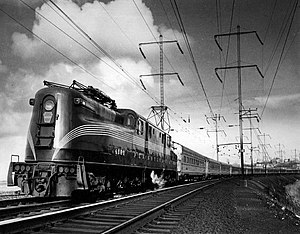PRR GG1

A GG1 pulls The Congressional
|
|||||||||||||||||||||||||||||||||||||||
|
|||||||||||||||||||||||||||||||||||||||
|
|||||||||||||||||||||||||||||||||||||||
|
|||||||||||||||||||||||||||||||||||||||
|
|||||||||||||||||||||||||||||||||||||||
| Type and origin | |
|---|---|
| Power type | Electric |
| Designer |
GE Transportation, Donald R. Dohner & Raymond Loewy |
| Builder |
GE Transportation (15), Altoona Works (124) |
| Build date | 1934 – 1943 |
| Total produced | 139 |
| Specifications | |
|---|---|
| AAR wheel arr. | 2-C+C-2 |
| UIC class | (2′Co)(Co2′) |
| Gauge | 4 ft 8 1⁄2 in (1,435 mm) |
| Leading dia. | 36 in (914 mm) |
| Driver dia. | 57 in (1,448 mm) |
| Wheelbase |
Rigid: 13 ft 8 in (4.17 m) Overall: 69 ft 0 in (21.03 m) |
| Length | 79 ft 6 in (24.23 m) over coupler pulling faces |
| Width | 10 ft 4 in (3.15 m) |
| Height | 15 ft 0 in (4.57 m) over locked-down pantographs |
| Adhesive weight | 303,000 lb (137,000 kilograms) |
| Loco weight | 475,000 lb (215,000 kilograms) |
| Fuel capacity | 3,000 lb (1,360 kg) or 424 US gal (1,610 l; 353 imp gal) oil, for train heating |
| Water cap | 23,000 lb (10,400 kg) or 2,760 US gal (10,450 l; 2,300 imp gal) for train heating |
| Electric system(s) | 11-13.5 kV 25 Hz AC Catenary |
| Current collection | dual pantographs |
| Traction motors | 12 × GEA-627-A1 385 hp (287 kW) |
| Transmission | AC current fed via a 22 position transformer tap changer to paired traction motors geared to a Quill drive |
| Train heating | One oil-fired 4,500 lb/hr steam generator |
| Performance figures | |
|---|---|
| Maximum speed |
Passenger: 100 mph (160 km/h) Freight: 90 mph (145 km/h) |
| Power output |
Continuous: 4,620 hp (3,450 kW) Short duration: 8,500 hp (6,300 kW) @ 65 mph (105 km/h) |
| Tractive effort | 65,500 lbf (291 kN) |
| Career | |
|---|---|
| Operators | Pennsylvania Railroad, Penn Central, Conrail, Amtrak, New Jersey Transit |
| Locale | Northeast Corridor |
| First run | January 28, 1935 |
| Last run | October 29, 1983 |
| Disposition | 16 preserved, the rest scrapped. |
The PRR GG1 was a class of electric locomotives built for the Pennsylvania Railroad (PRR), in the northeastern United States. Between 1934 and 1943 General Electric and the PRR's Altoona Works built 139 GG1s.
The GG1 entered service with the PRR in 1935 and later ran on successor railroads Penn Central, Conrail and Amtrak. The last GG1 was retired by New Jersey Transit in 1983. Most have been scrapped, but several are in museums.
The GG1 was 79 feet 6 inches (24.23 m) long and weighed 475,000 pounds (215,000 kg). The frame of the locomotive was in two halves joined with a ball and socket joint, allowing the locomotive to negotiate sharper curves. The body rested on the frame and was clad in welded steel plates. The control cabs were near the center of the locomotive on each side of the main oil-cooled transformer and oil-fired train-heating boiler. This arrangement, first used on the Modified P5 class, provided for greater crew safety in a collision and for bi-directional operation of the locomotive. A pantograph on each end of the locomotive body was used to collect the 25 Hz, 11,000 V alternating current (AC) from the overhead lines. In operation the leading pantograph was usually kept lowered and the trailing raised to collect current, since if the rear pantograph failed it would not strike the forward pantograph. Transformers between the two cabs stepped down the 11,000 V to the voltages needed for the traction motors and other equipment.
...
Wikipedia
